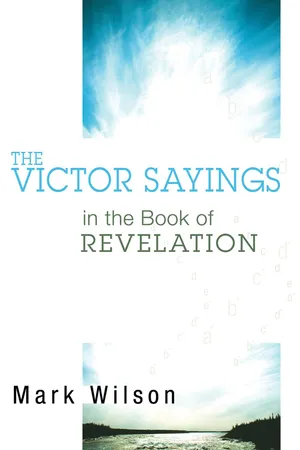1
The Structure of the Seven Letters and Revelation
Introduction
The victor sayings with their catchword nika,w are part of a larger literary unit, the seven letters, which themselves comprise a section within Revelation. To understand how these sayings function rhetorically, it is necessary to locate them first within these larger literary units. As Ulfgard has well observed, “no attempt at understanding a part of Rev can be made without having a general idea of its place within the whole book.” Therefore we begin our study by examining the vexing problem of Revelation’s structure. In spite of a growing mass of research, little consensus exists regarding structure. Michaels in his exegetical guide to Revelation makes this pessimistic assessment that “there are as many different outlines as there are interpreters.” And Barr, who served for years as chairman of the Society of Biblical Literature seminar on Reading the Apocalypse, likewise states in a recent paper: “There is no consensus on how we should organize or outline the material in the book. There are almost as many outlines as there are commentators doing the organizing.”
The truth of these statements is clearly seen in the analysis by Lombard of structural outlines by five leading commentators. Lombard includes Kraft, Hahn, Lambrecht, Schüssler Fiorenza, and Hellholm. While certain similarities are apparent, one is struck by the profound differences among the outlines of these five authors. Add the eight others whom Michaels references plus his own, and it is apparent that a major interpretive problem is at work. If scholars cannot agree on a structural approach, it is understandable that the average reader has difficulty making sense of the book’s organization. Yet, as Rissi acutely observes, “In scarcely any other biblical book are the method of exposition and the understanding of the book’s literary structure so thoroughly intertwined as they are in the Revelation to John. The question of construction deeply touches the highly problematic character of the book.”
Many commentators consider Revelation 1:19 to be a structural key to the book: “Therefore, write what you have seen, what is and what is about to happen after this.” Schüssler Fiorenza affirms this observation, “The passage most generally used for dividing the book is Rev. 1:19.” Whether the verse suggests a twofold or a threefold division is hotly debated, and Beale has provided a complete discussion of the options.
In his widely circulated commentary Walvoord advocates a threefold division: “The things referred to as having already been seen are those contained in chapter 1 . . . . The second division, ‘the things which are,’ most naturally includes chapters 2 and 3 . . . . The third division, ‘the things which shall be hereafter,’ would naturally include the bulk of the book which was to be prophetic.” The futurist interpretive view, which Walvoord represents, sees the events of chapters 4–22 as occurring in the period immediately preceding the parousia. The church is seen as raptured in chapter 4 and thus out of the picture during the judgments depicted in the seals, trumpets, and bowls. Because the word “church” does not appear after chapters 1–3, Walvoord concludes “that the church may be considered as in heaven and not related to events which will take place on the earth in preparation for Christ’s return in power and glory.”
Discontinuity between chapters 1–3 and 4–22 is the hallmark of this interpretation, which from a literary perspective is difficult to sustain. Schüssler Fiorenza rightly points to the book’s continuity: “As the seventh element of the preceding seven-series opens up a new series of visions in the plague septets of the book, so the seventh element of the letter vision opens up a new series of visions. It is therefore inappropriate to separate the letter septet from the following visions of the book.” She also observes that such a division suborns authorial intent “since it separates parenesis and apocalyptic vision.” While 1:19 can assist in understanding the temporal perspectives within the prophecy, it cannot provide a macrostructure for the book.
The seven letters of chapters 2–3 are perhaps the most familiar section of Revelation. While many studies note the unique structure of the seven letters for rhetorical effect (this will be developed in chapter 2), few consider the macrostructure of these chapters in terms of chiasmus. Likewise, the promises in the victor sayings with their corresponding fulfillments in the book’s final chapters suggest that chiasmus may be a possible macrostructure for Revelation. We will now explore whether chiasmus may be the structural key both for the seven letters as well as for the entire book.
Chiasmus as a Structural Technique in Ancient Literature
The burgeoning interest in rhetorical criticism has led to increased focus on the role of chiasmus as a structural device in ancient literature. Kenned...
